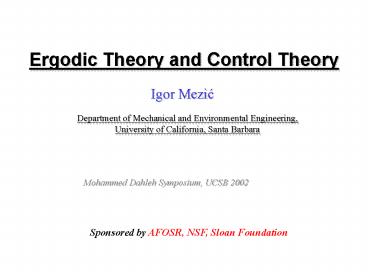Ergodic Theory and Control Theory - PowerPoint PPT Presentation
1 / 12
Title:
Ergodic Theory and Control Theory
Description:
Applications: -molecular dynamics, vortex dynamics, satellite ... Jim Swift's page: http://odin.math.nau.edu/~jws/std.map/ Hamiltonian systems: twist maps ... – PowerPoint PPT presentation
Number of Views:87
Avg rating:3.0/5.0
Title: Ergodic Theory and Control Theory
1
Ergodic Theory and Control Theory
Igor Mezic
Department of Mechanical and Environmental
Engineering, University of California, Santa
Barbara
Mohammed Dahleh Symposium, UCSB 2002
Sponsored by AFOSR, NSF, Sloan Foundation
2
Introduction
- Control of Hamiltonian systems
Applications -molecular dynamics, vortex
dynamics, satellite
motion control, quantum control, power systems
- Volume-preserving systems on groups.
3
Introduction
T
4
Ergodicity and Controllability
5
Ergodicity and Controllability
Observation 2 For Uw, w irrational, the
system is almost reachable. In
fact, for irrational w the system is
ergodic.
6
Ergodicity and Controllability
Theorem Assume A is a compact abelian
topological group, U an input set of
positive Haar measure and g an element
of U such that gn is dense in G. Then
the system TU is controllable.
Remark The element g is an ergodic element. Its
presence in the input set is
necessary Let G-1,1 under multiplication.
Then U1 is an input set of measure ½ but 1 is
not an ergodic element, and the element -1 is NOT
reachable.
7
Ergodicity and Controllability
- Stronger results are possible, where only
dim(U)gt0 is necessary.
- Extensions for more general systems e.g. linear
systems - with input constraints continuous-time
Hamiltonian systems - vortex dynamics.
8
Hamiltonian systems twist maps
Jim Swifts page http//odin.math.nau.edu/jws/st
d.map/
9
Hamiltonian systems twist maps
By Zoran Levnajic (UCSB/Trieste).
10
Hamiltonian systems twist maps
Kolmogorov-Arnold-Moser theorem implies
No controllability!
11
Hamiltonian systems twist maps
12
Discussion and Conclusions
- Controllability results for Hamiltonian and
- volume-preserving systems extensions for N DOF
- With D. Vainchtein control of (Hamiltonian)
- vortex dynamics using properties of nominal
dynamics. - Control of statistical properties conserved
quantities.
- Linking ergodic theory and control theory
- 1. Control of mixing.
- 2. Nonlinear model validation.
- 3. Ergodicity and controllability.































